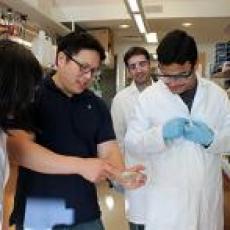
Protein degradation is a powerful mechanism of controlling protein function. Damaged or improperly folded proteins need to be cleared from the cell before they elicit toxic effects. Regulatory proteins need to be degraded so that the response they elicit can exist only as long as it is necessary. However, as proteolysis is an irreversible event, the cell must also take care to only degrade those factors as needed without disturbing the balance of other proteins. In eukaryotes, exquisite selectivity is generated through cascades of specific molecular events that together yield a polyubiquitination signal that targets a substrate for degradation. As no such system exists in bacteria, the highly specific nature of protein degradation must be accomplished at the level of direct recognition of the substrate or by utilizing auxiliary factors to improve specificity. The general goals of the Chien lab are to understand how these substrates are recognized in a precise fashion and the impact of substrate degradation on regulatory networks of the cell.
A number of critical unresolved questions emerged from these observations. How does CtrA degradation occur specifically at the G1-S transition? How does dephosphorylated CpdR activate ClpXP and what is the molecular nature of this interaction? Interestingly, although ClpXP is essential, CtrA degradation is not needed for viability. If ClpXP is necessary because of its proteolytic activity, what substrates must be degraded? Because targeted proteolysis is critical for virulence and environmental sensing pathways in many bacteria, a deeper understanding of its regulation will shed light on how cells respond to environmental cues and could potentially lead to development of new antibiotic therapies.
My lab has now addressed these questions using biochemistry, structural biology and cell biology. We have found that CpdR phosphorylation gates its ability to prime the ClpXP protease for selective substrate degradation (Lau, et al. Molecular Cell 2015). We have identified an adaptor hierarchy that degrades substrate classes dependent on the degree of assembly of this hierarchy (Joshi, et al. Cell 2015). We have identified ~100 proteins associated with the ClpP protease, many of which are central regulators (Bhat, et al. Molecular Microbiology 2013). Finally, we have uncovered new modes of partial proteolysis in bacteria where processing of an essential replication factor is necessary for normal growth (Vass, et al. PNAS 2013).
Our ability to identify factors needed for the precisely timed degradation of key substrates and to biochemically reconstitute activity using purified components affords us unique insight into the process of regulated proteolysis. By understanding how mechanisms specific to our system enforce proper protein lifetimes, we hope to understand how regulated proteolysis is generally controlled. Furthermore, as ClpX is a member of a larger class of other molecular machines whose primary role is to aid in the proper folding of proteins, lessons learned from our studies will also shed light on a broader understanding of energy driven protein folding and unfolding.